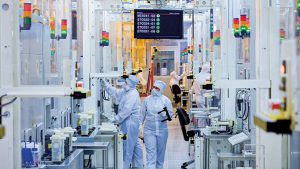Bloomberg
The Biden administration published its strategy for subsidising US output of semiconductors, with the first phase of funding potentially being rolled out next spring, Commerce Secretary Gina Raimondo said.
Smaller, simpler projects involving expansion of existing facilities will be the first to receive funds, followed by more complex projects for so-called leading-edge chips, which the US currently doesn’t produce but consumes more than 25% of global supply, Raimondo told reporters in Washington.
The plan — known as Chips for America — allocates $28 billion for domestic production of leading-edge logic and memory chips, about $10 billion for new capacity to build current-generation chips and semiconductors, and $11 billion for a new National Semiconductor Technology Center, manufacturing institutes, and other development programs, the Department of Commerce said in a statement accompanying the strategy’s release.
“We’re going to be pushing companies to go bigger and be bolder,†Raimondo said in Washington. “So if a company already has funding now for $10 billion project, we want them to think bigger and and convince us how they can go from $10 billion to $50 billion with use of the taxpayer financing.â€
President Joe Biden signed the $52 billion Chips and Science Act legislation into law August 9. It’s the centerpiece of his administration’s effort to reduce dependence on Asian suppliers like Taiwan and South Korea, whose local companies are leading the global market, and to address supply-chain disruptions and resulting price hikes for certain goods containing semiconductors.
Commerce will release funding documents that will provide specific application guidance for the program by early February, it said.
“Awards and loans will be made on a rolling basis as soon as applications can be responsibly processed, evaluated and negotiated,†it said.
There are clear guardrails on the money, in that companies can’t use the funds for stock buybacks, Raimondo said. The department will ensure those who receive chips funds can’t compromise national security by investing in China.
The department also will have the ability to claw back money if a recipient company fails to start or complete a project on time, Raimondo said.
The US government is tightening flows of technologies to China, most recently restricting sales of artificial intelligence chips and cutting-edge chip gear to Chinese customers. It is also considering moves to restrict US investment in Chinese tech companies, while at the same time offering billions of dollars in incentives to bolster semiconductor production on American soil. Washington is demanding that any chipmaker receiving a part of the federal grant refrain from manufacturing advanced chips in China for a period of ten years. The Korean government is seeking to negotiate that with US officials.
As the US beefs up efforts to solidify a chip supply chain at home, Samsung announced plans for an advanced $17 billion chip plant in Taylor, Texas, with construction slated to start later this year.
The new plant would lure new clients with closer partnerships, Kyung said, adding the company will continue to invest in the US.
Samsung has also floated the idea of a broad expansion of its semiconductor manufacturing facilities in Texas, laying out potential plans to spend almost $200 billion on 11 plants in a series of filings in the state in July.
 The Gulf Time Newspaper One of the finest business newspapers in the UAE brought to you by our professional writers and editors.
The Gulf Time Newspaper One of the finest business newspapers in the UAE brought to you by our professional writers and editors.
